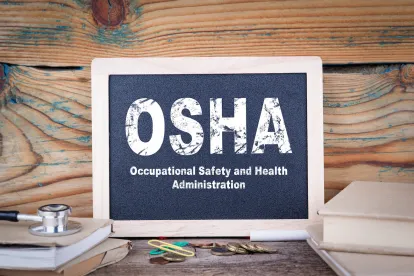In our alert series, Plan Now for Bringing Back Your Workforce, we’ve explored the importance of creating an OSHA-compliant Infectious Disease Preparedness and Response Plan, explained how to go about doing so, and examined the legal risks associated with resuming operations during the coronavirus pandemic.
Not surprisingly, new information is coming to light almost daily. This alert provides updates on three developments that relate to bringing back your workforce:
-
EEOC’s issuance of new guidance on high-risk employees
-
New Guidance from OSHA for nursing homes, and jointly from OSHA & CDC for manufacturing facilities
-
Reinforcement by OSHA’s parent agency, the U.S. Department of Labor, of the importance of formal Infectious Disease Preparedness and Response Plans for employers that are the subject of complaints to OSHA.
1. EEOC’s Guidance on High-Risk Employees
Before we discuss the guidance itself, we offer this important context. Some epidemiologists and other experts note that the most important metric relating to resuming more full-scale economic activity is getting the rate of spread down to less than one new infection per existing infection. This is known as the R0 factor. The Massachusetts High Tech Council, for example, recommends that to get that metric to R, employers should segment their workforces by vulnerability to COVID-19, bringing back younger and healthier workers first, and workers over 60 or with certain medical conditions last. The goals are laudable: to continue driving down the infection rate and protect the health care system. But is the practice legal?
EEOC began issuing what it calls Technical Assistance Questions and Answers about COVID-19 in mid-March. The primary focus of the agency’s Q&A guidance format has been in the area of disabilities as they may relate to, or be impacted by, COVID-19. EEOC has consistently maintained that the general principles applicable to the accommodation of disabilities, including medical inquiries, apply as before. EEOC has been helpful in expressly stating that employee screening, temperature taking, and even COVID-19 testing are permissible medical inquiries, because the risk of infecting coworkers constitutes a “direct threat” to the health of other employees (meaning there is a “significant risk of substantial harm” to other employees), making the inquiries job-related and consistent with business necessity.
But how does that direct threat concept apply in the context of protecting employees themselves, as opposed to their coworkers? The distinction between threat to coworkers and threat to self has become magnified by the pandemic: age and certain medical conditions are highly correlated with more severe illness and even death. It is comparatively easy to address the coworker threat by simply not allowing the infected employee into the workplace. But what about protecting well, but more at-risk, employees from infection? How might employers take these accepted medical facts into account in planning for the return of their workforce?
Employees with Health-Related Risks from COVID-19: The “Direct Threat” Standard
The “direct threat” standard applied to the risk of infection looks quite different when applied to the issue of infection of employees themselves. When considering steps to prevent infections in higher risk employees, the ADA, and thus the EEOC, is less forgiving. In its May 7 update to the Technical Assistance Q&A, in questions G.4 and G.5, the EEOC said:
If the employer is concerned about the employee’s health being jeopardized upon returning to the workplace, the ADA does not allow the employer to exclude the employee – or take any other adverse action – solely because the employee has a disability that the CDC identifies as potentially placing him at “higher risk for severe illness” if he gets COVID-19. Under the ADA, such action is not allowed unless the employee’s disability poses a “direct threat” to his health that cannot be eliminated or reduced by reasonable accommodation ….The ADA direct threat requirement is a high standard … [that] requires an employer to show that the individual has a disability that poses a “significant risk of substantial harm” to his own health …. A direct threat assessment cannot be based solely on the condition being on the CDC’s list.
Employers must engage in an individualized assessment of each high-risk employee’s disability, along with factors such as the duration of the risk, the nature and severity of the potential harm, the likelihood the harm will occur, and the imminence of the harm. This means considering the severity of the pandemic in the region, the employee’s ability to control the effects of the disability, and the employee’s particular job duties. If consideration of these factors leads to a reasonable conclusion that a direct threat exists, the employer must then exhaust all possible reasonable accommodations. Only then can the employee be excluded from working. Obviously, all mitigating measures being taken under the employer’s plan (hygiene, distancing, barriers, staggered shifts, etc.) will be relevant, as will accommodations such as working from home.
There are two sides to this coin: the high-risk employee who wants to get back to the workplace despite the risk, and the high-risk employee who does not. For the high-risk employee who wants to return to the workplace and does not seek any accommodation, employers are not required to engage in the direct threat analysis. Many employers will not be satisfied with taking that risk and will want to seek to engage proactively in an interactive process to see what accommodations might be available to allow the employee to work while reducing the threat. This idea is laudable, but it’s critical to remember that an employer would need to have specific, individualized information, lawfully obtained, about an employee’s health that would justify triggering that process. For example, if the employee has used emergency paid sick leave because a health care provider recommended they self-isolate due to an underlying medical condition, the employer will be aware that there’s an underlying health condition that heightens the employee’s risk. In that case, it would be very logical – indeed advisable – for the employer to talk to the employee and perhaps even the employee’s health care provider about risk and possible accommodations. Otherwise, the onus is on the employee to initiate the dialogue and if s/he is willing to forge ahead without accommodation and accept the risk, so must the employer.
On the other hand, an employer may genuinely believe it has the risk well-enough controlled, even for the most vulnerable among its workforce, but one or more high-risk employees nevertheless do not want to return to their workplace because of the fear of infection. The accommodation process would be the same, and the objective medical and other facts may make it advisable for the employer to provide an accommodation, even if it’s not convinced one is necessary, and it would rather not provide one. If the employee rejects the employer’s attempted accommodations altogether and simply refuses to come to work, the employer will be faced with the difficult choice of placing the employee on leave, or termination.
Employees with Age-Related Risks from COVID-19: High Risk for Employers
What if the higher risk is not disability-related at all, but simply a function of age? EEOC has yet to issue any guidance on this question. While there are a couple of possible arguments under the Age Discrimination in Employment Act for why it might be permissible for employers to treat older workers differently because of the greater threat to their health, we do not have any confidence that these arguments will be accepted, and employers should not attempt to segment their workforce by age or even suggest to older employees that they should stay away from the workplace for that reason.
It remains to be seen whether the EEOC’s approach to how established anti-discrimination principles apply during a pandemic will evolve. For now, however, we have significant concerns that whatever the benefits to population health, the practice of workforce segmentation as described above carries significant legal risk for employers. Instead, when analyzing high-risk employees, your best bet is to stick with existing ADA principles.
2. New Guidance
OSHA Guidance for Nursing Homes & Long-term Care Facilities
Last week, OSHA issued specific guidance for nursing homes and long-term care facilities. While this one-page guidance will likely contain nothing new in the area of infection control measures, keep in mind that OSHA’s focus is on employee safety, not patients. We urge anyone in that industry to review that guidance and to make sure your plan is consistent with it.
OSHA & CDC Joint Guidance for the Manufacturing Industry
Also last week, OSHA and the CDC issued interim guidance for manufacturing workers and employers. If you are in the manufacturing industry, we urge you to review this guidance as soon as possible to make sure your plan is consistent with its standards.
3. US Department of Labor Comments on Infectious Disease Preparedness and Response Plans
Last week, USDOL Acting Assistant Secretary of Labor Laura Sweat echoed the advice we have been giving about the importance of adopting formal Infectious Disease Preparedness and Response Plans. Her message was straightforward: companies with these plans will benefit from OSHA’s exercise of discretion with respect to possible citations arising out of safety complaints made to OSHA, while employers without such plans will not. This means that if your organization has a plan, and is following it, the chances are good that you will not be cited and fined as part of the resolution of an employee complaint. Without such a plan, expect no benefit of the doubt.
At the same time, it has become public knowledge that in response to union and other complaints that OSHA is not being active enough in protecting workers’ safety during the pandemic, the DOL Inspector General will be looking into OSHA’s enforcement activities. That means employers should expect increased activity on the inspection front. Your plan is by far your best defense.



 />i
/>i

